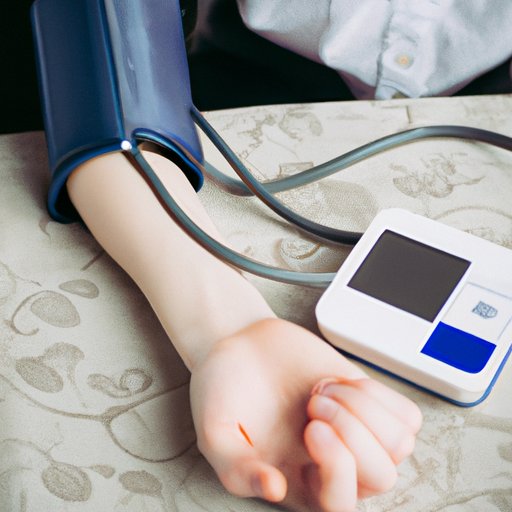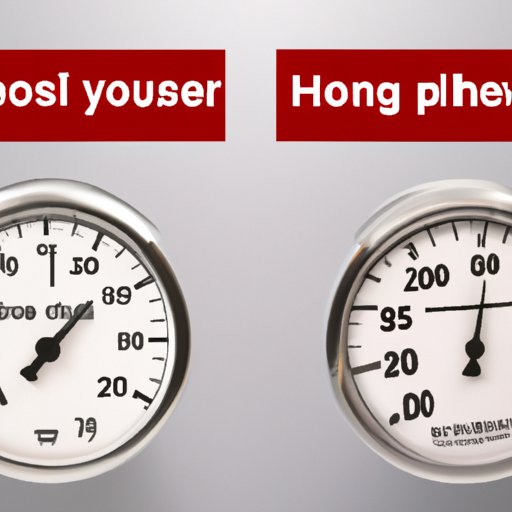
Introduction
Blood pressure is a crucial indicator of our overall health. It shows the pressure that blood exerts on the walls of the arteries, and it can impact a range of bodily functions. Low blood pressure, or hypotension, can cause a multitude of symptoms, including fatigue, feeling dizzy, and even fainting. In this article, we will explore the relationship between low blood pressure and fatigue, examine the causes of hypotension, and discuss ways to manage it.
Explaining the Relationship Between Blood Pressure and Energy Levels
Blood pressure refers to the force that blood puts on the walls of the arteries as it travels through the body. It consists of two numbers: the top number (systolic pressure) indicates how much pressure the blood exerts on the arteries when the heart pumps, while the bottom number (diastolic pressure) indicates how much pressure the blood exerts on the arteries when the heart is resting between beats.
Blood pressure is essential for carrying oxygen and nutrients throughout the body’s organs and tissues. When it drops too low, these essential substances may not circulate properly, causing fatigue, weakness, and dizziness.
Symptoms of low blood pressure that cause fatigue include feeling tired easily, experiencing nausea, and having difficulty concentrating. In severe cases, it may even lead to fainting.
Causes of Low Blood Pressure
There are multiple causes of low blood pressure, including a lack of fluid intake, blood loss, or the use of medications. Dehydration, for example, can cause blood volume to decrease, leading to a drop in blood pressure. Blood loss can cause a reduction in red blood cells, which carry oxygen throughout the body.
Several medications, such as diuretics, beta-blockers, and antidepressants, can also lower blood pressure and cause fatigue. Other underlying medical conditions, including heart problems and hormonal imbalances, can also lead to hypotension.
Impact of Low Blood Pressure on Daily Activities
The effects of low blood pressure on daily life can be significant and have a negative impact on everyday activities. People with hypotension may experience difficulty performing everyday tasks, such as showering or grocery shopping, without feeling lightheaded or dizzy. These symptoms may lead to a decline in workplace productivity, and people with hypotension may need to limit or avoid physical exercise.
The impact of hypotension on daily life can be substantial, as people may feel like they are unable to enjoy life’s simple pleasures, like spending time with their loved ones outdoors.
Managing Low Blood Pressure
There are several steps people can take to manage low blood pressure. One first important step is to increase fluid intake. Drinking plenty of fluids can help prevent dehydration, which can lower blood volume. It’s important to maintain a healthy diet and eat foods that are rich in nutrients, such as lean proteins, whole grains, fruits, and vegetables.
It’s also vital to avoid triggers that can lower blood pressure, such as alcohol consumption and hot weather. When people feel faint, dizzy, or experience other symptoms associated with low blood pressure, it’s important to rest and lie down until the symptoms pass.
In some cases, people may need to seek medical assistance for low blood pressure that doesn’t respond to these measures. Some people may require medication or other interventions to regulate blood pressure levels and alleviate symptoms.
Diagnosis of Low Blood Pressure
Doctors diagnose low blood pressure through a series of tests, including blood tests, exam, and monitoring blood pressure over time. They may also use imaging tests, such as ultrasounds, to look at the structure of the heart and blood vessels.
Blood pressure readings are generally taken from the arm or wrist using a blood pressure cuff, which inflates and deflates to measure blood pressure. The numbers obtained from this process consist of two numbers — systolic and diastolic pressure. Readings below 90/60 mmHg are generally considered indicative of low blood pressure.

High Blood Pressure vs. Low Blood Pressure
While low blood pressure can lead to fatigue, high blood pressure can cause other health concerns, such as an increased risk of heart disease and stroke. High blood pressure refers to blood pressure readings above 130/80 mmHg, whereas low blood pressure readings are below 90/60 mmHg. Both conditions can be managed through lifestyle changes and medication, when necessary.
Conclusion
Low blood pressure is a condition that can cause fatigue, dizziness, and other symptoms that can negatively impact daily life. However, with proper management techniques, such as increasing fluid intake and avoiding triggers, people can alleviate these symptoms. It’s important to seek medical assistance if symptoms persist or worsen, as some people may require further intervention to regulate their blood pressure. Overall, taking steps to manage low blood pressure can help people feel more energized, comfortable, and able to enjoy life.




